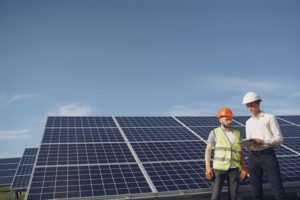 Our home solar guide will walk you through the first three steps you’ll need to take on the way to installing solar power. First, look into options for funding your project. Next, choose a system to bring solar to your home. Finally, select a solar installer to work with for your project. Let’s walk through this guide to going solar and bring you closer to savings on your energy bill.
Our home solar guide will walk you through the first three steps you’ll need to take on the way to installing solar power. First, look into options for funding your project. Next, choose a system to bring solar to your home. Finally, select a solar installer to work with for your project. Let’s walk through this guide to going solar and bring you closer to savings on your energy bill.
Funding Your Home Solar
Based on a nationwide sample in 2020, home solar installation costs an average of $12,000 to $15,000 in the United States after tax credits. [1]Solar Energy Industries Association, https://www.seia.org/solar-industry-research-data It takes an average of five to ten years for the average home solar installation to completely pay for itself in energy savings. This upfront investment is a barrier for some homeowners. If you can’t float these costs, there are several options to bring solar power to your household.
 If you want to purchase your own solar panels but don’t have the budget upfront, you could get started with a solar loan. A secured solar loan allows you to borrow against the vale of your house, which gets you low interest rates and fees. With an unsecured loan, you can borrow against the panels and avoid risking other assets.
If you want to purchase your own solar panels but don’t have the budget upfront, you could get started with a solar loan. A secured solar loan allows you to borrow against the vale of your house, which gets you low interest rates and fees. With an unsecured loan, you can borrow against the panels and avoid risking other assets.
If owning your solar panels isn’t a requirement, you might want to look into Community Solar options or a Solar Purchase Agreement (PPA). Community Solar programs allow you to share a system that is co-owned with neighbors. PPAs, on the other hand, are an agreement for someone else to install solar panels on your property. You’ll pay only for the amount of energy that your home uses, and you won’t have the upfront costs of installation or maintenance. With either of these alternatives, you won’t see the same amount of savings that you would by owning your panels. But Community Solar and PPAs are good alternatives giving you access to clean power.
Another way to share the costs is to get a solar lease. Usually you will lease your solar panels for a fixed monthly fee and pay for your energy by the watt. It’s a lot like leasing a car and then paying for gas.
See our home solar guide to going solar costs and savings for more information about your funding options.
Choosing a System
 In order to select your solar installation company, you’ll want to become familiar with the different systems they offer for home solar. Do you want to grid-tied, or off-grid? Roof panels or ground-mounted panels? Each system has its pros and cons, and it really depends on your goals. Brush up on your vocabulary with our solar power guide and begin to figure out which system is the best match for your household. Even if you’re not sure right away, familiarizing yourself with the options will help you to have better conversations with your installer.
In order to select your solar installation company, you’ll want to become familiar with the different systems they offer for home solar. Do you want to grid-tied, or off-grid? Roof panels or ground-mounted panels? Each system has its pros and cons, and it really depends on your goals. Brush up on your vocabulary with our solar power guide and begin to figure out which system is the best match for your household. Even if you’re not sure right away, familiarizing yourself with the options will help you to have better conversations with your installer.
Selecting Your Installer
It can save you as much as 10% on your project to choose your solar installation company wisely. Our best tip is to look for smaller companies with a strong track record, and to compare quotes. You’ll also want to compare their warranty terms and long-term maintenance support. If the company you’re considering can offer testimonials from plenty of satisfied customers, that should be a key factor for you. If they are also a small company that does fewer than 1,000 jobs every year, then they might offer the perfect combination of high quality and low going solar costs of installation.
Ready to make the switch to home solar power? Test your knowledge with a Going Solar quiz.
(Illustrations: calulator by ic2icon, Power House by Vectors Point)
References
| ↑1 | Solar Energy Industries Association, https://www.seia.org/solar-industry-research-data |
|---|
